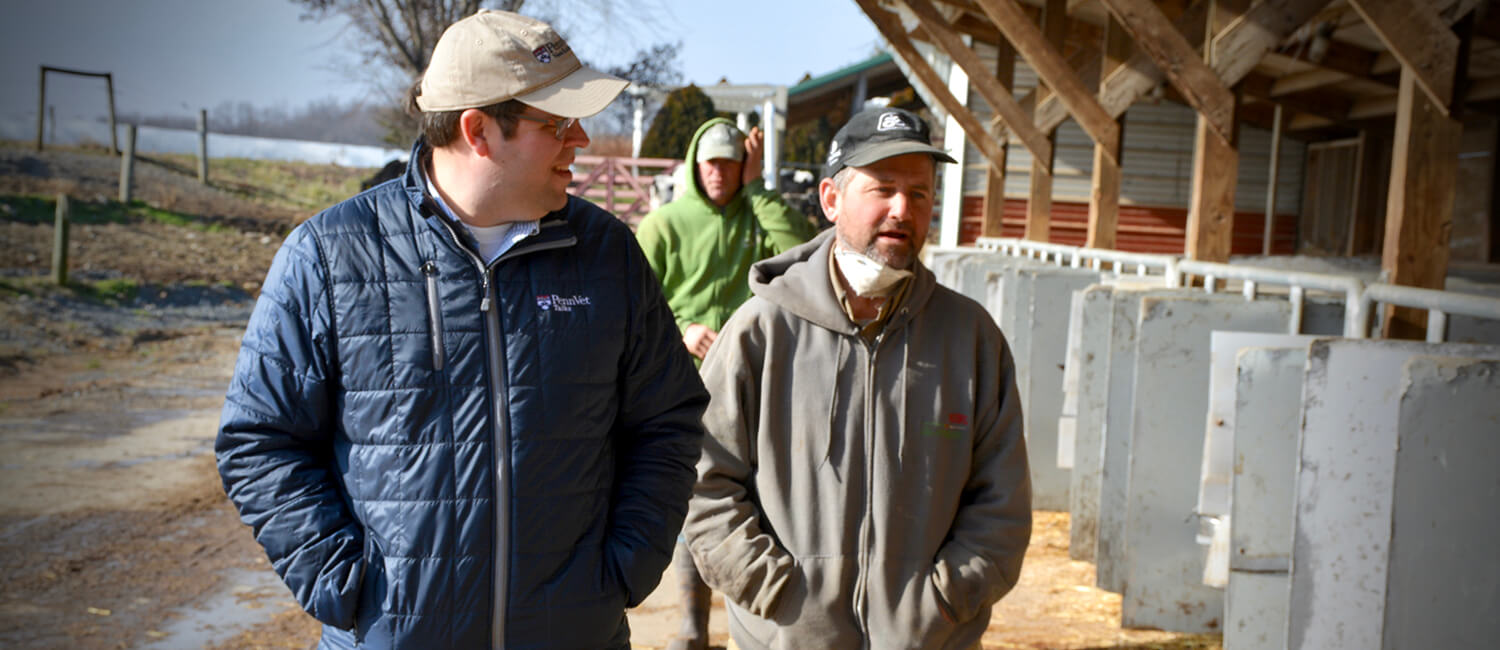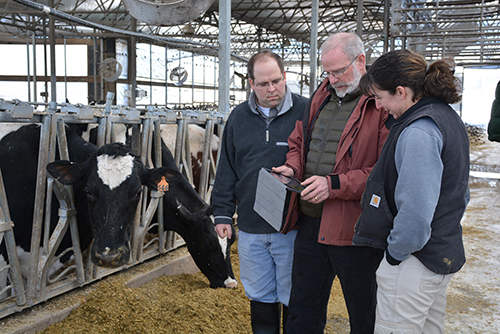



For Improved Profit Margins, the Dairy Doctor is in
For Dr. Joe Bender, what goes on in the environment surrounding an animal is just as important as what’s going on inside of it.
As a veterinarian and assistant professor of clinical dairy production medicine within the Center for Animal Health and Productivity (CAHP) at the University of Pennsylvania’s School of Veterinary Medicine (Penn Vet), Bender knows how an integrated approach to herd health can pay off in the bulk tank.
There’s no question that in order to be productive, a cow must be healthy with reproductive soundness and access to good nutrition. But sometimes, despite healthy animals, producers are still unable to meet the financial obligations of the farm. “We refer to this as caring for the ‘health’ of the farm. Healthy animals alone do not guarantee a profitable farm,” Bender says.
In fact, troubleshooting the ‘health’ of the whole farm, rather than that of the individual cow, is the most common challenges seen by Bender on his farm visits. And these symptoms of poor ‘health’ almost always take a hit on the farm’s bottom line. “Either poor production is limiting profitability or the producer is looking for ways to improve production – to increase profitability,” Bender finds. “The challenge is finding the sweet spot. That’s where our team comes in.”
Bender defines this sweet spot as finding ‘farm balance’: harmonizing the number of cows with adequate production to meet vital cash flow demands. This approach looks beyond making sure a farm is providing enough resources to support animal health, but also is allocating appropriate support to hired labor and practicing good environmental stewardship.
“Understanding the underlying factors that are important to support the health of the farm is where our integrated approach comes in,” Bender states. This entails evaluating all areas of the operation -- replacement animals, transition cows, milk production, reproduction and culling, economics of production and environmental stewardship.
Bender left private practice to join the faculty of Penn Vet in 2014, bringing with him the benefit of both in-barn experience and being an academic veterinarian. However, these days Bender finds himself spending most of his time off campus providing consultative support to the region’s dairy producers, dealing with real-world, on-farm issues.
“It is easy to migrate down a path and work to address issues that have minimal impact on farm profitability, while missing the big picture items that are critical to maintain the health of the farm,” Bender cautions. “The technological resources and multi-dimensional expertise that Penn Vet’s herd health team is able to provide producers helps to keep these efforts in focus to drive strategic, meaningful change.”
BREEDING GROUNDS FOR FARM EFFICIENCY
Bender’s approach starts with evaluating a herd’s reproductive data. “Reproductive efficiency drives everything on a dairy farm – from daily milk output to the number of cows and heifers in the herd. Poor reproductive efficiency is a huge limiting factor for a dairy to be profitable,” Bender says.
“If your herd pregnancy rate is below 23 percent, seek help to find out why,” Bender advises. A pregnancy rate above 23 percent means a farm is capturing economic benefits from their reproductive program; anything below that benchmark suggests the opposite..jpeg)
That said, Bender believes that nutrition, by and large, has the greatest impact on a dairy’s income potential and farm expenses. “Nutrition trumps everything else,” he states. If the diet is balanced incorrectly or there is an issue with a feedstuff, other tactics like cow comfort upgrades will be ineffective and add additional fixed costs.
While most producers are current on ration and supplements thanks to a consultant who manages their feed program, Penn Vet’s dairy herd health experts often find many producers need a better handle on how much it costs to feed a cow and how to track that metric over time. Bender routinely gets asked by farmers, “How much does my ration cost?” It’s a great question and the answer should be on the front page of every producer’s notebook. For the farms consulted by Bender and his team, feedstuffs alone account for 40-60 percent of all expenses on a dairy farm.
Monitoring production parameters such as milk pounds, components, and milk urea nitrogen also lend key insights for both the producer and nutritionist on how a farm’s cows are utilizing their feed ration. Revisiting or reworking a ration is indicated when forage sources change or inventories limit inclusion rates. Changes in purchased feed ingredients also signal a need to start pencil pushing.
CENTS AND SENSIBILITY
Bender is starting his sixth year at Penn Vet. “I have yet to visit a herd for a suspected disease requiring testing,” he says. “That is because in dairy, we have a fairly good handle on the traditional definition of animal health.” The issue limiting profitability varies from high cost of production to low milk output.
“Completing a cash flow analysis and finding opportunities for a producer to improve is critical and allows for benchmarking,” Bender says, adding, “Almost every farm I have visited over the years has an aspect of their operation that is limiting their profitability, including high feed costs, large loan payments, and poor crop yields. Identifying the problem is not that hard – coming up with a game plan to correct the issue is more difficult, time consuming, and intensive over a long period of time.”
According to some economists, 2020 holds promise for rising milk prices; the decisions made today will determine tomorrow’s milk production. “Aside from correcting an obvious nutritional issue, it generally takes six to 12 months for producers to see the fruits of their labor and witness increases in milk production,” Bender says.
“It is a misconception for producers to see an increase in milk price and then think it’s time to get down to business and get the cows milking,” he warns. This approach does not work and will lead to inputs into the dairy trying to improve milk production that have negative return on investment and will ultimately negate improved milk prices.
If prices do rise, Bender agrees with economists who suggest proceeding cautiously with any profits that are generated. “Milk prices will likely increase but not to levels that we have seen in earlier years,” Bender expects. Getting current on accounts payable and reestablishing lines of credit should be the focus in preparation for 2021. Capital purchases that do not increase revenue directly should be approached with caution.
Bender’s final piece of advice to producers seeking improved margins is work tirelessly to improve feed quality, including better management practices regarding the cropping program, and incorporating hybrid selections and timing of harvest. “The effects of poor forage quality are endless and really limit profit,” he concludes.


